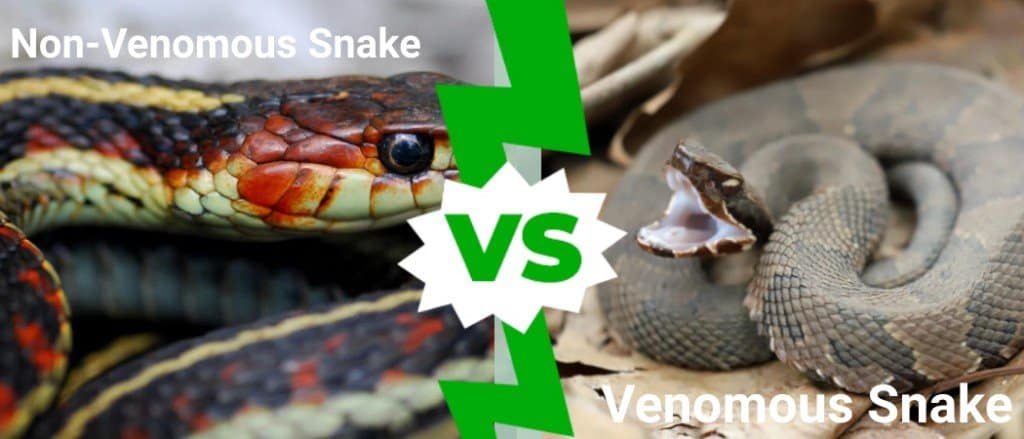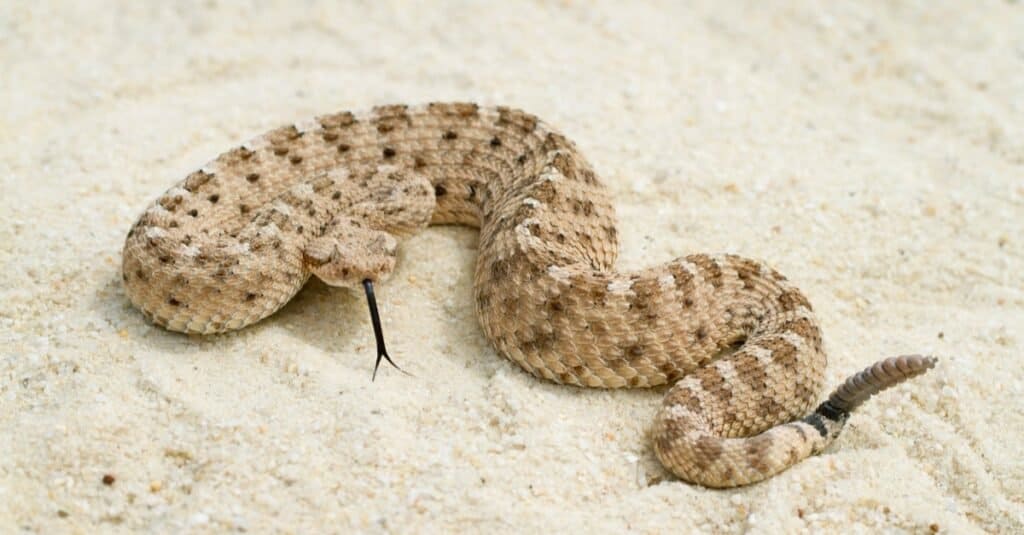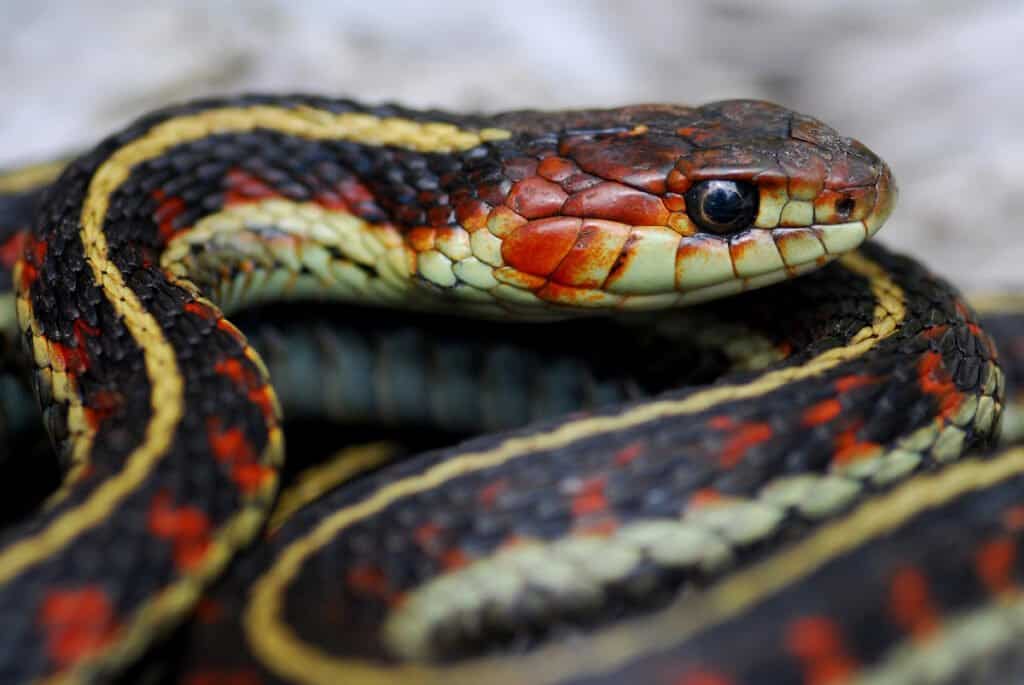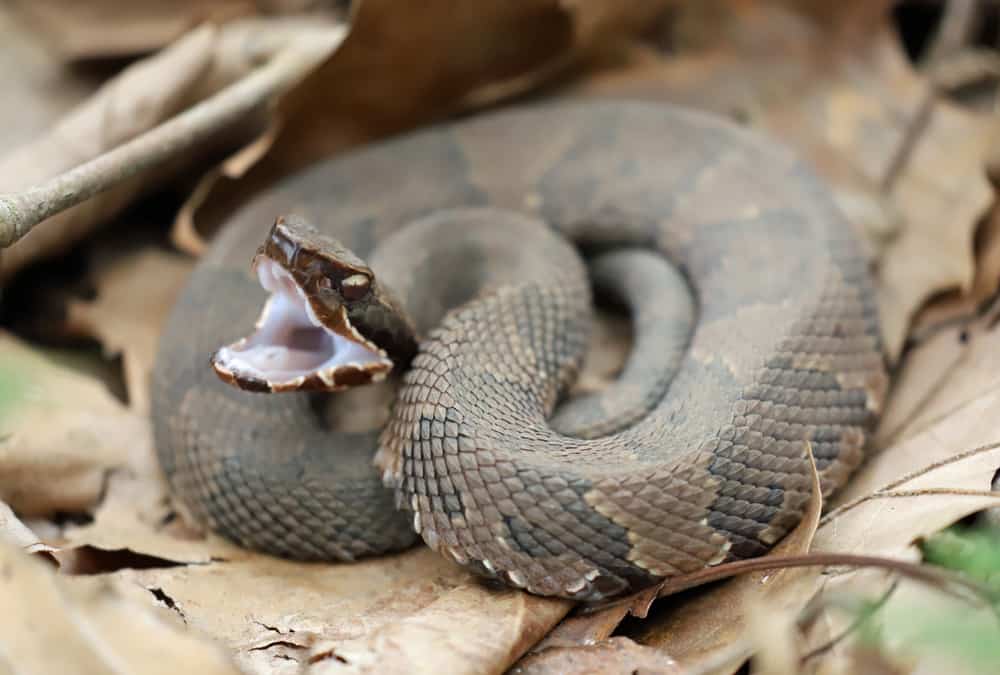Venomous vs Non-Venomous Snake: What’s the Difference?
It can be a lifesaver to learn the differences between venomous vs non-venomous snakes. While it can be difficult to tell upon first glance, especially if you stumble upon a snake while hiking, the difference between these two snake types becomes clear after only a bit of study.
Knowing what to look for will give you confidence and peace of mind for whenever you encounter a snake next, because there are key differences, both physical and internal. You don’t have to get bitten by a venomous snake in order to identify it as such! Let’s go into detail about the key differences between venomous vs non-venomous snakes.

A-Z-Animals.com
Comparing Venomous vs Non-Venomous Snakes
| Venomous | Non-Venomous |
| Head Shape Triangular with pits | Rounded and without pits |
| Rattle? Sometimes | Never |
| Pupils Elliptical or vertical slits | Rounded pupils |
| Tail Shape Can end in a rattle or a different color | Tail tapers to a thin end; no rattle |
| Coloring Brightly colored or very patterned | Often less colorful and one solid color |
| Method of Killing Venom | Constriction |
| Venomous? Yes | No |
The 5 Key Differences Between Venomous vs Non-Venomous Snakes
There are key differences that separate venomous vs non-venomous snakes. Besides the presence of venom, a venomous snake often has other distinguishable characteristics. For example, venomous snakes often have a rattle on the end of their tails; non-venomous snakes will never have a rattle. Venomous snakes also have a different head shape and pupil shape when compared to non-venomous snakes.
Let’s dive a little deeper into what makes venomous and non-venomous snakes so different.

iStock.com/BobMcLeanLLC
Venomous vs Non-Venomous Snakes: Venom
One of the key differences between venomous vs non-venomous snakes is the presence of venom. It may sound obvious that venomous snakes have venom while non-venomous snakes don’t, but this is a key distinction to make between these two types of snake.
Non-venomous snakes can still bite and behave aggressively, often more aggressively than venomous snakes. However, they can’t inject their prey or predators with venom. This may not make them safer to interact with, but it does make them less deadly than venomous snakes.

Mark_Kostich/Shutterstock.com
Venomous vs Non-Venomous Snakes: Head Shape
A key difference between venomous and non-venomous snakes is their head shape. This can be a fantastic way of telling these two types of snakes apart, especially if you stumble upon one in the wild. Venomous snakes often have a triangular shaped head, while non-venomous snakes have a more rounded head.
However, non-venomous snakes can mimic venomous snakes as a defense mechanism, flattening their heads to appear more triangular in nature. This can lead to some confusion, but venomous snake heads are very wide at the base, when their head meets their neck. Non-venomous snakes won’t have the same width to their heads.
Venomous vs Non-Venomous Snakes: Pupil Shape and Pits
Another easy difference between venomous vs non-venomous snakes is the shape of their pupils and the presence of facial pits. Venomous snakes have vertical pupils similar to cats’ narrow slits that appear threatening.
Non-venomous snakes have round pupils, filling out the entirety of their eyes. This is a very important distinction to make between venomous vs non-venomous snakes as there are very few exceptions to this rule. If you stumble upon a snake in the wild, take the time to look at their eyes if it is safe to do so.
Another key distinction between venomous vs non-venomous snakes is the presence of pits on their face. Venomous snakes have unique holes in between their nostrils and eyes that allow them to detect slight temperature differences in prey; non-venomous snakes do not have pits.

Jason Mintzer/Shutterstock.com
Venomous vs Non-Venomous Snakes: Presence of a Rattle
Venomous snakes can have a rattle on the end of their tails while non-venomous snakes will never have a rattle. However, not all venomous snakes have a rattle- it is meant to be an automatic tell rather than an absolute rule. Non-venomous snakes can also mimic the sound of a snake’s rattle inside of their bodies.
This is an important distinction to make between the two types of snakes. If you hear a rattle, always look for one on the end of the snake’s tail- though hearing a rattle is a good sign to back off, no matter the type of snake!

KF2017/Shutterstock.com
Venomous vs Non-Venomous Snakes: Markings and Color
The final key difference between venomous and non-venomous snakes is their markings and colorings. While there is no hard and fast rule, markings can help you identify whether or not a snake is venomous. Many non-venomous snakes are solidly colored, without very much brightness or distinct markings; venomous snakes can be very vivid and distinct in their coloring and markings.
However, this is not an absolute rule- there are many snakes, both venomous and non-venomous that break this rule entirely. But if you happen to see a snake that is one solid and dull color, you may have stumbled upon a non-venomous snake!
Discover the “Monster” Snake 5X Bigger than an Anaconda
Every day A-Z Animals sends out some of the most incredible facts in the world from our free newsletter. Want to discover the 10 most beautiful snakes in the world, a “snake island” where you’re never more than 3 feet from danger, or a “monster” snake 5X larger than an anaconda? Then sign up right now and you’ll start receiving our daily newsletter absolutely free.
More from A-Z Animals
It can be a lifesaver to learn the differences between venomous vs non-venomous snakes. While it can be difficult to tell upon first glance, especially if you stumble upon a snake while hiking, the difference between these two snake types becomes clear after only a bit of study.
Knowing what to look for will give you confidence and peace of mind for whenever you encounter a snake next, because there are key differences, both physical and internal. You don’t have to get bitten by a venomous snake in order to identify it as such! Let’s go into detail about the key differences between venomous vs non-venomous snakes.

A-Z-Animals.com
Comparing Venomous vs Non-Venomous Snakes
| Venomous | Non-Venomous |
| Head Shape Triangular with pits | Rounded and without pits |
| Rattle? Sometimes | Never |
| Pupils Elliptical or vertical slits | Rounded pupils |
| Tail Shape Can end in a rattle or a different color | Tail tapers to a thin end; no rattle |
| Coloring Brightly colored or very patterned | Often less colorful and one solid color |
| Method of Killing Venom | Constriction |
| Venomous? Yes | No |
The 5 Key Differences Between Venomous vs Non-Venomous Snakes
There are key differences that separate venomous vs non-venomous snakes. Besides the presence of venom, a venomous snake often has other distinguishable characteristics. For example, venomous snakes often have a rattle on the end of their tails; non-venomous snakes will never have a rattle. Venomous snakes also have a different head shape and pupil shape when compared to non-venomous snakes.
Let’s dive a little deeper into what makes venomous and non-venomous snakes so different.

iStock.com/BobMcLeanLLC
Venomous vs Non-Venomous Snakes: Venom
One of the key differences between venomous vs non-venomous snakes is the presence of venom. It may sound obvious that venomous snakes have venom while non-venomous snakes don’t, but this is a key distinction to make between these two types of snake.
Non-venomous snakes can still bite and behave aggressively, often more aggressively than venomous snakes. However, they can’t inject their prey or predators with venom. This may not make them safer to interact with, but it does make them less deadly than venomous snakes.

Mark_Kostich/Shutterstock.com
Venomous vs Non-Venomous Snakes: Head Shape
A key difference between venomous and non-venomous snakes is their head shape. This can be a fantastic way of telling these two types of snakes apart, especially if you stumble upon one in the wild. Venomous snakes often have a triangular shaped head, while non-venomous snakes have a more rounded head.
However, non-venomous snakes can mimic venomous snakes as a defense mechanism, flattening their heads to appear more triangular in nature. This can lead to some confusion, but venomous snake heads are very wide at the base, when their head meets their neck. Non-venomous snakes won’t have the same width to their heads.
Venomous vs Non-Venomous Snakes: Pupil Shape and Pits
Another easy difference between venomous vs non-venomous snakes is the shape of their pupils and the presence of facial pits. Venomous snakes have vertical pupils similar to cats’ narrow slits that appear threatening.
Non-venomous snakes have round pupils, filling out the entirety of their eyes. This is a very important distinction to make between venomous vs non-venomous snakes as there are very few exceptions to this rule. If you stumble upon a snake in the wild, take the time to look at their eyes if it is safe to do so.
Another key distinction between venomous vs non-venomous snakes is the presence of pits on their face. Venomous snakes have unique holes in between their nostrils and eyes that allow them to detect slight temperature differences in prey; non-venomous snakes do not have pits.

Jason Mintzer/Shutterstock.com
Venomous vs Non-Venomous Snakes: Presence of a Rattle
Venomous snakes can have a rattle on the end of their tails while non-venomous snakes will never have a rattle. However, not all venomous snakes have a rattle- it is meant to be an automatic tell rather than an absolute rule. Non-venomous snakes can also mimic the sound of a snake’s rattle inside of their bodies.
This is an important distinction to make between the two types of snakes. If you hear a rattle, always look for one on the end of the snake’s tail- though hearing a rattle is a good sign to back off, no matter the type of snake!

KF2017/Shutterstock.com
Venomous vs Non-Venomous Snakes: Markings and Color
The final key difference between venomous and non-venomous snakes is their markings and colorings. While there is no hard and fast rule, markings can help you identify whether or not a snake is venomous. Many non-venomous snakes are solidly colored, without very much brightness or distinct markings; venomous snakes can be very vivid and distinct in their coloring and markings.
However, this is not an absolute rule- there are many snakes, both venomous and non-venomous that break this rule entirely. But if you happen to see a snake that is one solid and dull color, you may have stumbled upon a non-venomous snake!
Discover the “Monster” Snake 5X Bigger than an Anaconda
Every day A-Z Animals sends out some of the most incredible facts in the world from our free newsletter. Want to discover the 10 most beautiful snakes in the world, a “snake island” where you’re never more than 3 feet from danger, or a “monster” snake 5X larger than an anaconda? Then sign up right now and you’ll start receiving our daily newsletter absolutely free.







